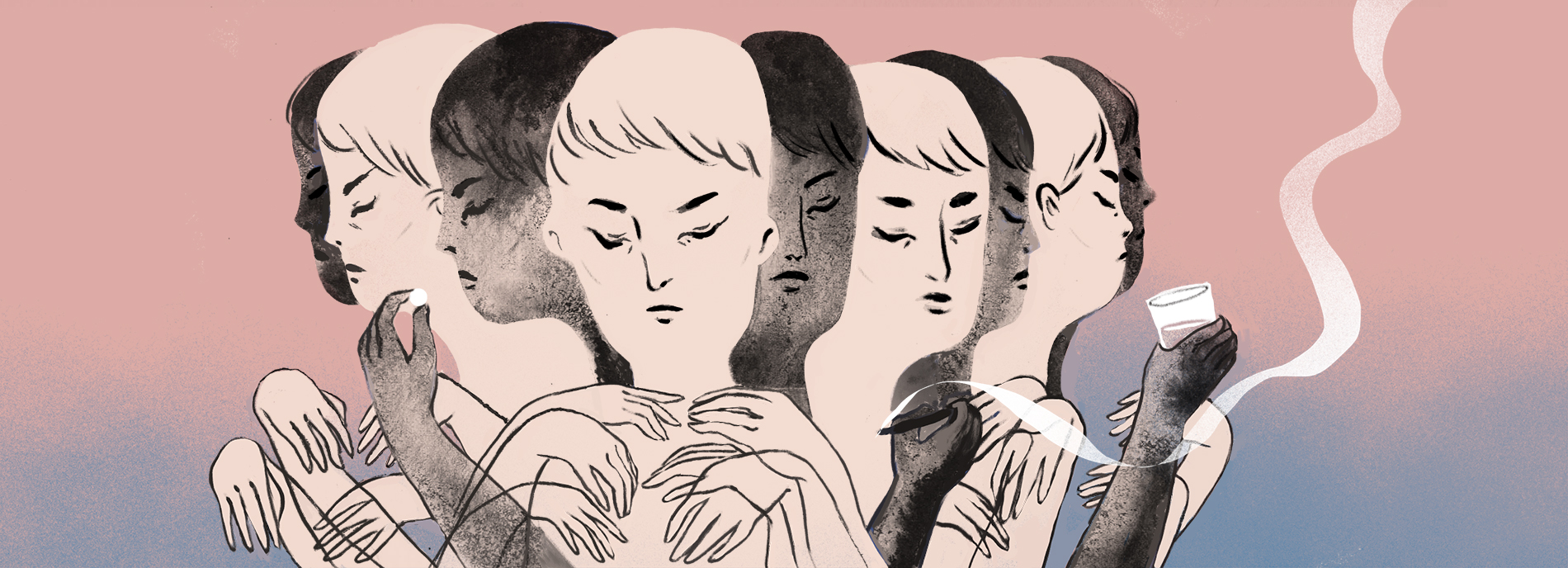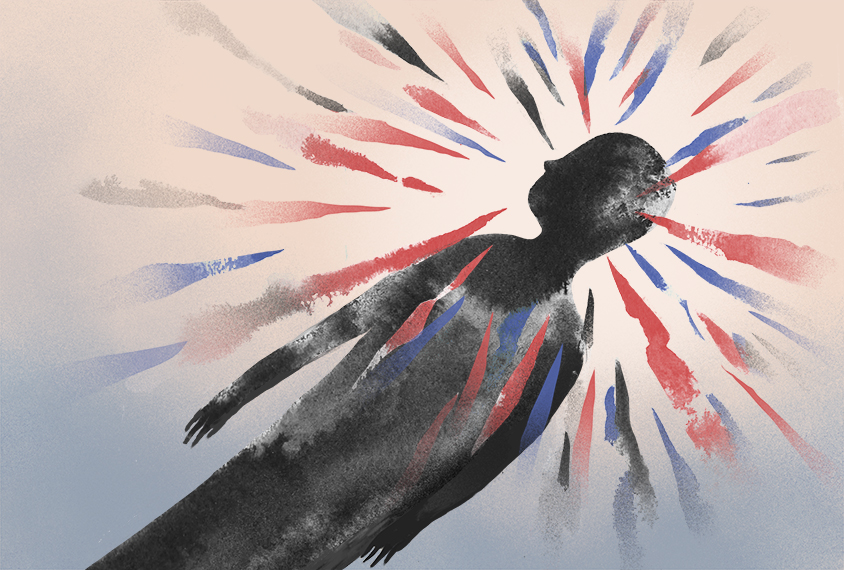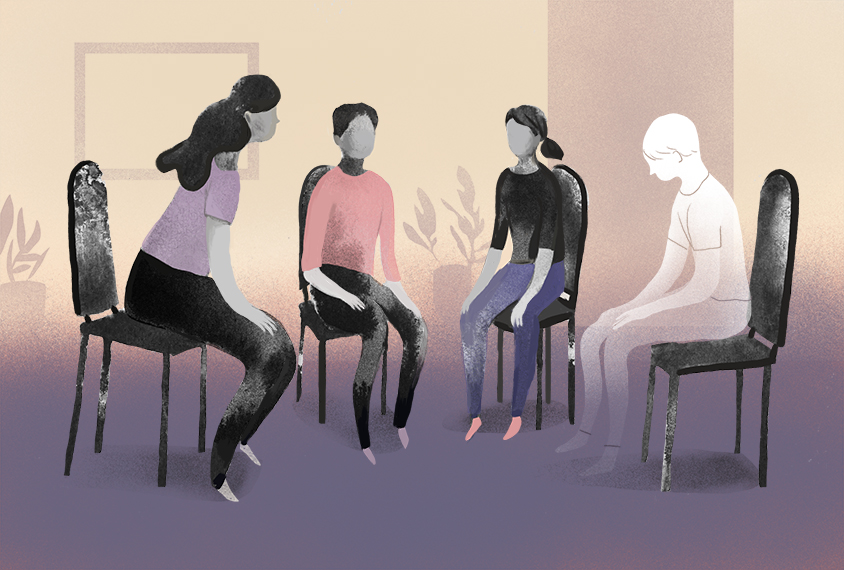
Autism’s hidden habit
Conventional wisdom holds that people with autism don’t get hooked on alcohol or other drugs, but new evidence suggests otherwise.
S
hane Stoner’s addiction began in 2008. He lost a factory job, his parents divorced, his father died — and then a relative introduced him to heroin. “I felt like heroin gave me confidence,” Stoner says. “I could get out of bed in the morning and do the day. No matter what happened, it made me feel like it was going to be all right.” It erased his constant anxiety.Stoner, now 44, eventually entered detox in 2013 after he was arrested for stealing copper from an abandoned house. It was obvious at that point that he was addicted to heroin. But it would take several more years for him to get the diagnosis that truly helped him understand himself: autism.
The new label came as a relief. It explained Stoner’s sensitivity to things such as tags on his T-shirts, and his succession of obsessive interests. It clarified why he had such a difficult time fitting in as a child, his problems with roommates in college — and why he continued to struggle with social connections as an adult. “I can’t believe nobody ever mentioned it before, because I started thinking back and there’s pictures of me, like, 3 years old, and I’m honestly flapping my hands.”
Stoner is now three years into recovery from his addiction. “I like my autism now that I know what it is,” he says. “I don’t like all parts of it — I don’t like the anxiety — but it’s like it all made sense.”
Until recently, researchers held that addiction among people with autism is rare, although there wasn’t much solid evidence for this view. It seemed plausible, though: Many people with autism have a penchant for strictly following rules, which would seem to make them less likely to try alcohol or illegal drugs. Because people with autism are often isolated from their peers, this could protect them from the peer pressure that can lead to youthful experimentation. And many people diagnosed with autism decades ago had severe features; a person who can’t live independently has few opportunities to become addicted.
A new study in Sweden, however, suggests that people with autism who have average or above-average intelligence quotients (IQs) are more than twice as likely to become addicted to alcohol or other drugs as their peers are. The risk is even higher for people who also have attention deficit hyperactivity disorder (ADHD). This study is the first to look at the general risk for addiction among people with autism.
Other research is also finding unexpected biological and psychological commonalities between the two conditions. “These two fields have really developed independently, but I think there could be a lot of cross-fertilization,” says Patrick Rothwell, assistant professor of neuroscience at the University of Minnesota Twin Cities in Minneapolis. In 2016, Rothwell opened a lab focused on studying the biological and behavioral parallels between addiction and autism.
There are similarities in the way people with either condition use repetitive behaviors to cope with emotional problems, as well as in their impulsivity and compulsions. The two conditions affect some of the same brain regions and involve some of the same genes. These connections are spurring a new area of research that could eventually help improve both autism care and addiction treatment and prevention.
”“No matter what happened, [heroin] made me feel like it was going to be all right.” Shane Stoner
New numbers:
F
or much of the 20th century, most of those who received an autism diagnosis were on the severe end of the spectrum. In this largely nonverbal population, addiction seemed unlikely. But in 1994, when the “Diagnostic and Statistical Manual of Mental Disorders” added Asperger syndrome as a category, the spectrum extended to people who had much more opportunity to access alcohol and other drugs. Still, for years, the assumption remained that addiction was one concern the autism community could safely ignore.When Espen Arnevik reviewed the literature for a paper he published last year, he found only 18 studies that looked at the overlap between autism and addiction. Each of them looked mainly at select samples — such as people being treated for addiction, or those caught up in the criminal justice system — rather than at the general population.
Arnevik found that the combined prevalence of alcoholism and addiction in people with autism ranged from 0.7 percent to 36 percent. Because the data were so varied, the range couldn’t be narrowed down any further. Overall, however, “most studies suggest a significantly lower prevalence than in the general population,” says Arnevik, associate professor of psychology at the University of Oslo in Norway. In the United States, the lifetime prevalence of alcoholism is 14 percent; for other substance addictions, the figure hovers around 2 to 3 percent (there is some overlap between these groups).
Given the prevailing impression that addiction is uncommon among people with autism, the findings of the Swedish study came as a surprise to many. The study analyzed national health registry records of the 1.3 million Swedes who were born between 1973 and 2009, and identified 26,986 people diagnosed with autism. The researchers also determined how many of those with autism had an additional diagnosis of intellectual disability, substance use disorder or ADHD.
Overall, an autism diagnosis doubles the risk of addiction, the researchers found. Elevated risk is concentrated among those with an IQ of 100 or above. But across the spectrum, ADHD is a great multiplier of risk: Among those with autism and intellectual disability, having ADHD increases the risk of addiction fourfold; among those with an IQ in the typical range or above, ADHD increases the risk eightfold.
Parents and siblings of people with autism also have a higher risk of addiction, suggesting a genetic link.
These findings don’t necessarily conflict with earlier data showing lower addiction risk among people with autism, says Paul Lichtenstein, professor of genetic epidemiology at the Karolinska Institute in Sweden, who worked on the study. The main takeaway, he says, is that risk varies with level of intellectual ability. Previous research often included a much higher proportion of people with intellectual disability, which would have skewed the results.
On the other hand, autism is often diagnosed later in Sweden than in the U.S., and the proportion of people at the milder end of the spectrum may be higher. That may cause the increase in addiction risk to look larger than it is, notes Jeremy Veenstra-VanderWeele, associate professor of psychiatry at Columbia University. “I would want to see whether this paper’s findings hold up when [autism] follows the typical pattern of relatively early recognition, rather than quite late diagnosis.” Another possibility: Given the wide variety of people on the spectrum, it is possible that some types of autism raise risk, whereas others lower it.
The Swedish finding comes as less of a surprise to people with autism. Matthew Tinsley, now 55, had always looked to alcohol and prescription drugs to reduce his anxiety. Tinsley is author of “Asperger Syndrome and Alcohol: Drinking to Cope,” one of the few books on this subject. (He has been sober since 2004.) From an early age, he would take his mother’s anxiety medications when he felt overwhelmed. “I found being amongst groups of people very stressful,” he says.

In college, he discovered that alcohol also helped ease socializing. “Everyone else is drinking, it’s socially acceptable, and if you drink, you fit in because everyone else is doing it,” he says. “It took the edge off.” By the time he was in his 40s, Tinsley adds, he was drinking “lethal” amounts of alcohol: 3 liters of gin every day. This led to cirrhosis, and he entered rehab in 2004. As in Stoner’s case, his autism diagnosis in 2005 came as a relief. Once he realized there was an explanation for his sensory and social difficulties, he began to be kinder to himself and found healthier ways of coping.
The link between autism and addiction is also unsurprising to clinicians who work with people on the spectrum. Valerie Gaus, a psychologist in the New York City area, says of her clients with autism who have drinking or drug problems, many of the older ones turn to alcohol, whereas the younger ones tend to use marijuana.
Eric Hollander has seen a similar pattern. However, he says he treats more behavioral addictions, such as gambling. “I work with a lot of people with [autism] who have all kinds of impulsive behaviors,” says Hollander, director of the Autism and Obsessive Compulsive Spectrum Program at Albert Einstein College of Medicine in New York. “In fact, that’s one of the main targets when people come in for treatment. Either they’re out of control in terms of shopping on the internet or gaming, or they’re just addicted to the internet.”
Hollander has looked at similarities between obsessive compulsive disorder, addiction, and the impulsive and compulsive behaviors that occur in people with autism. He proposes that these conditions, all characterized by repetitive thought and behavior, should be grouped together as ‘obsessive compulsive spectrum disorders’ in the diagnostic guidelines.
Impulsivity — acting quickly without thinking — and compulsivity, or being unable to stop an activity once it has started, are both problems of self-control, or ‘executive function.’ Impulsivity is strongly linked with the risk for becoming addicted; addiction is defined as compulsive drug use that persists despite negative consequences. People with autism show signs of both impulsivity and compulsivity. For example, they frequently engage in repetitive, compulsive behaviors — dubbed ‘stimming’ — to address either a lack of sensory stimulation or a surfeit of it. In the case of addiction, different types of addictive drugs can enhance or reduce sensation.
Tanea Paterson, a mother of two who lives in New Zealand, used drugs to deal with social stress, but also to cope with her sensory problems. A mixture of heroin and other illegal opioids, her drug of choice, “wound down my senses to a more bearable level,” she says. Using drugs also gave Paterson routines, she says. “They were predictable in an unpredictable world.”
Paterson kicked her addiction more than 10 years ago, but didn’t find out she has autism until 2015. Her son had previously been diagnosed with autism, and she convinced the therapist who had helped him to evaluate her. For Paterson, too, the diagnosis brought relief: “It was a lifting of so much guilt and shame in many, many ways,” she says.
Paterson had been bullied and excluded as a teenager before she found peers who used marijuana and were more accepting. In this group, she felt safer, she says. Others with autism and addiction also report that drug culture helps them feel accepted: Unusual behavior is expected when people are high, so they don’t stand out.
”“These two fields have really developed independently, but I think there could be a lot of cross-fertilization.” Patrick Rothwell
Deeper links:
A
ddiction is known to be linked to changes in the striatum, a central region of the brain involved in pleasure, motivation and habitual behavior. During a period of addiction, control over drug-related behavior shifts from one region of the striatum to another.Before drug use devolves into addiction, drug-related brain activity occurs primarily in the ventral area, which is involved with motivation and seeking pleasure. At this stage, people take drugs mainly because they offer either comfort or joy. The ventral region seems especially connected to impulsive behavior. But as addiction progresses, some of the action moves toward the dorsal striatum, a region involved in automating behavior into more programmed patterns, which can be set off by specific cues. This automation can be useful when it processes a complex dance move or other skill into a single, willed action — but it can also create a compulsion that, once unleashed, becomes difficult to restrain.
The compulsion could be drug use, but it could also be the repetitive behaviors of autism. In both cases, the striatum drives the persistent behavior. It’s possible that in people with autism or addiction, the striatum is more prone to getting stuck in a repetitive pattern. “[Behavioral patterns] become very difficult to change once they’re well-practiced,” says Rothwell, who is among the few researchers who studies both autism and addiction. “That’s definitely a concept that I think is very relevant both to the repetitive symptoms of autism and the habitual patterns of addiction.”
Paterson, the New Zealand woman who formerly used opioids, says she sees these patterns in her own behavior: “I think of autistic inertia — can’t start, can’t stop — comfort in consistency, predictability and obsessiveness.”
Addiction and autism may also share genetic connections. For example, Rothwell has found that NLGN3, a candidate gene for autism, is highly active in the nucleus accumbens, a region in the ventral striatum that is linked to desire and drug use. “That was striking because that’s very much also an addiction hotspot,” Rothwell says.
Chromosomal region 16p11.2 is deleted in some cases of autism — and mice with this deletion show enlargements in the nucleus accumbens. CNTNAP4, another autism candidate gene, is also active in the striatum; mice that lack the protein have elevated levels of dopamine in the nucleus accumbens, which is a brain state that is common at the start of addiction.

There are also intriguing neurochemical connections between autism and addiction. Interactions between oxytocin, dopamine and the brain’s natural opioids in the striatum appear to be important in both conditions: Oxytocin is thought to connect the memory of specific people to pleasure, thereby creating social bonds. This process may go awry in some people with autism, and they may find socializing unrewarding or unpleasant. There may be parallels with addiction here as well. People with addiction often report feeling that social connection is difficult or even impossible, until they find solace in drugs.
Addiction also affects the brain’s endogenous opioid system, which produces the experience of pleasure and comfort most people feel when they socialize. Mice lacking genes involved in this system are less sociable than usual and engage in stereotyped behavior reminiscent of autism. “There’s some very interesting data out there that suggests there could be a deficiency in opioid signaling that might be a factor in autism,” says Rothwell.
Genes involved in the autism-related conditions Rett syndrome and fragile X syndrome also show up in addiction research. Neuroscientists were startled to find that MeCP2 — which is mutated in Rett syndrome — becomes highly active in the brain when rats are given access to large amounts of cocaine. FMR1, the gene mutated in fragile X syndrome, seems to have a similar relationship to cocaine addiction.
A better understanding of the connections between autism and addiction could provide important therapeutic insights into both, says Robert Malenka, professor of psychiatry at Stanford University in California, who worked with Rothwell on the NLGN3 research. “Clinicians in one field should pay attention to what is going on in the other field,” he says.
Autism and addiction research have already converged on one medication: baclofen, a drug approved in the U.S. for treating muscle spasms. A version of baclofen is in trials for treating autism and the related fragile X syndrome. The drug is also widely used in France to treat alcoholism, although clinical trials have shown mixed results. And preclinical research suggests it may help treat opioid and cocaine addiction.
For people on the spectrum who have addictions now, however, getting help can be challenging. There is not a single study on the best way to treat these individuals. In fact, there’s reason to believe that most addiction treatments are poorly suited to people with autism.
Addiction therapy is mainly conducted in group sessions, with strict rules requiring members to participate and articulate emotional problems. People with autism may respond to these expectations with anger and anxiety, which counselors may misinterpret as defiance. For those who are obligated to participate by the criminal justice system, failure to comply can even lead to incarceration.
Stoner, for one, says he had difficulty with rehab because he was made to spend many hours in group therapy and 12-step programs, including Narcotics Anonymous and Alcoholics Anonymous. “I’ve had a really hard time getting into that,” he says. When faced with speaking in front of a group or at an Alcoholics Anonymous meeting, “my mind goes blank,” he says. He also had difficulty connecting with other members. He was rejected twice before he found someone to be his ‘sponsor,’ or recovery mentor.
Given these difficulties, programs to help people with autism who have addictions may need to rely less on group therapies and more on individualized care.
Stoner now works as a peer specialist at the Kenmore Club, a government-funded project of the Rappahannock Area Community Services Board in Fredericksburg, Virginia. He says the organization’s more personal approach is better suited to his needs. The staff train people with various forms of developmental and psychiatric disabilities to help one another. Until more research is done, he says, people with both autism and addiction will have to find their own way to the best care.
Syndication
This article was republished in The Atlantic.
Recommended reading

Too much or too little brain synchrony may underlie autism subtypes

Developmental delay patterns differ with diagnosis; and more

Split gene therapy delivers promise in mice modeling Dravet syndrome
Explore more from The Transmitter

Noninvasive technologies can map and target human brain with unprecedented precision

During decision-making, brain shows multiple distinct subtypes of activity
